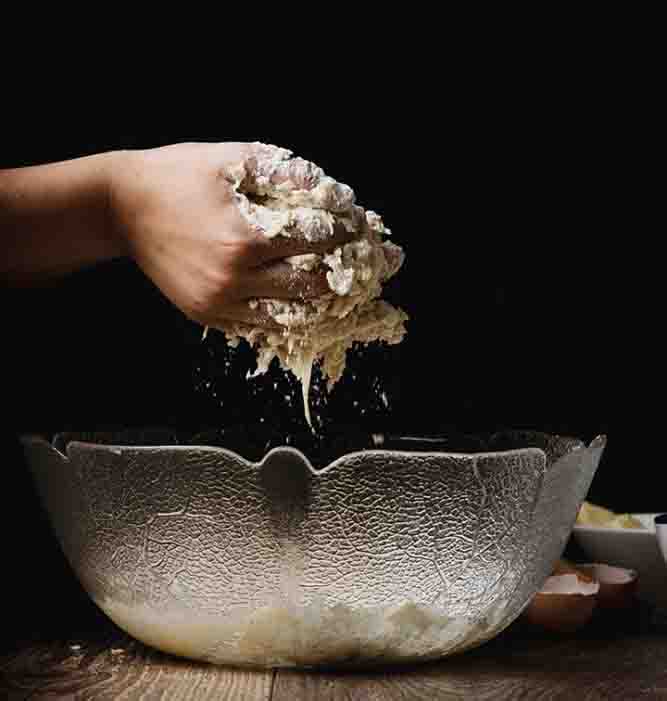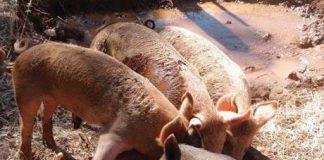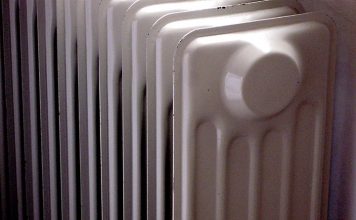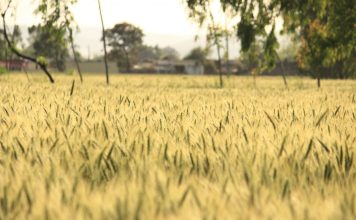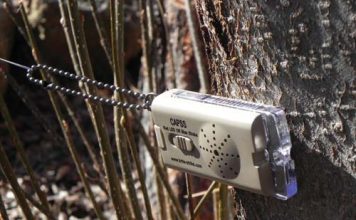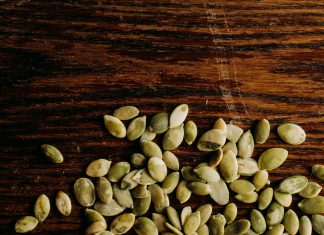 |
|
| Issue #82 • July/August, 2003 |
We’ve all been there; we are striving toward a self-reliant lifestyle, growing, raising, and foraging much of our family’s food. After all, we realize that not only does this give us control over what we eat (chemicals, ripening sprays, insecticides, bacteria, etc.), but home-raised foods taste terrific. Using these home-raised foods in quantity for daily meals allows us to eat cheaper, thus being able to put aside precious cash for other needs.
Our grandparents and some of our parents lived through the depression, and I know most of them say there was very little cash, but their family ate wonderful meals. By putting a little effort and imagination into it, meals using as many home-raised ingredients as possible can bestow untold riches on a family with a tight budget.
“Making your own” is not labor intensive and can be done in minutes.
Making cottage cheese
I’ve just set a big bowl of cottage cheese and I timed myself. Total time, so far, is 10 minutes. I’m working on this article now, and when I finish I’ll spend another few minutes before it is set to drain, nearly finished. And this will provide our family with five pounds of cottage cheese. Wonderful cheezie cottage cheese with no chemicals. Five pounds of that watered down stuff in a cottage cheese carton at the store costs over $12. So who wants five pounds of cottage cheese? Legitimate question. Well, I’ll pack two pounds in a freezer box and pop it into my freezer, we’ll eat a pound fresh, and the other two pounds I’ll press to make a basic cream cheese to use either with herbs on crackers, homemade bread, or in desserts such as cheesecake. I also use fresh cottage cheese in such things as lasagna.
The “hardest” part of making cottage cheese is first setting the starter. While you can inoculate milk for cheeses with commercial buttermilk, you will have some failures as it is sometimes weak and old. You can purchase freeze-dried packets of all-purpose cultures or specialized cultures for such cheeses as cheddar or blue cheese, should your cheese making expand. (Be warned that once you try the super-simple cottage cheese, you’ll immediately begin thinking of making all of your favorite cheeses.)
Making the cheese starter:
Have several ice cube trays on hand to hold 2 quarts. Check the cube sizes to see if they are 1 or 2 ounces, as you will need a measured amount of starter later on.
Sterilize a half-gallon canning jar and lid by boiling for 10 minutes. Set the jar to cool, upside down. Pour fresh, strained, warm-from-the-animal milk into the warm jar, then put the lid and ring on snugly. Place in a water bath canner full of hot water, totally immersing the jar. Bring to a boil, then reduce to a simmering boil for 30 minutes.
Remove jar from kettle and let it cool to room temperature. The milk will be about 72°. Inoculate the milk quickly, adding the starter, then put the cover back on and gently rotate the jar to dissolve the starter, mixing it thoroughly with the milk.
Wrap with a couple of towels and hold at 72° for about 16-30 hours. You can use a yogurt incubator or simply set it over the pilot of your gas stove or some other inventive place. When done, the milk will be firm, like yogurt. As you won’t be making 100 pounds of cheese, and as the starter will only remain good for about 3 days, it’s easiest to freeze the batch using ice cube trays. Cover the full trays with foil or plastic wrap and freeze. When hard, dump all the trays out into double baggies and store in the freezer. You can use all these cubes in the future for making cheeses, sour cream and other dairy products requiring a starter. Needless to say, I choose one day to make the starter (which only requires about an hour, all totaled) and another day to set my first batch of cheese.
Large curd cottage cheese:
1 gallon whole goat or cow milk
4 oz. of cheese starter (see recipe above)
1 tsp. rennet solution (4 drops liquid animal rennet mixed in 1/3 cup warm, boiled water)
(makes about 1½ pounds)
1. Fill sink with very hot water. Pour the milk into a stainless steel kettle or deep glass container. Place a dairy thermometer in the milk, and wait until it reaches 72°.
2. Add the cheese starter and 1 tsp. of the rennet solution. Stir well. Cover the container and allow to ripen at 72° for 24 hours or more until it sets into a thick, custard-like curd.
3. Line a colander with a damp cheesecloth and pour in the curd. Catch the whey and feed it to the pigs or chickens, or save for other uses.
4. Gather up the cheesecloth, tie it closed with sturdy clean cord, and hang up the bag of curds over a bowl to drain over night.
5. Turn the cottage cheese out and serve cold or use it in any recipe.
You may save some, pressing it very firmly in any innovative mold (tin can with holes, PVC mold, etc.), which will result in a cream cheese type texture, used as a spread or even in cheese cakes. We add fresh herbs, fruits, and even ground nuts to our cottage cheese and pseudo-cream cheese, and never have leftovers. Total cost of a pound and a half of cream cheese, if you have your own milk, is about 12 cents.
|
Want it even cheaper and quicker? I often use this method.
Heat one gallon of fresh, warm milk to 180° and remove from heat. Add ¼ cup cider vinegar to the milk. The curd will form immediately. Drain in cheesecloth for several hours. Now it is cottage cheese. Or you can further press it into a semi-soft, cream cheese type product. Total cost is about three cents.
Desserts
When you have your own chickens, you can discover hundreds of ways to use eggs in meals without resorting to plain old eggs all the time. Some of the “sneakiest” ways of disposing of a bounty of eggs is to crank out the desserts.
Grandma’s rhubarb pie:
One of my family’s favorite non-egg use of eggs is Grandma’s rhubarb pie. As we have abundant rhubarb both in the spring and in the pantry, we enjoy this special treat year-round. And because of the added eggs, this rhubarb pie recipe is not sour or bitter.
9″ pie pastry
fresh rhubarb to fill pie tin
1½ cups plus 1 heaping Tbsp. flour
½ tsp. salt
1 Tbsp. butter
3 eggs, separated
cold water
3 Tbsp. sugar
pinch salt
Line a 9″ pie tin with single pie pastry, fluting edge. Cut up enough fresh rhubarb to fill pie tin. In mixing bowl, combine 1½ cups of flour, 1 heaping Tbsp. flour, ½ tsp. salt, 1 Tbsp. butter. Add 3 slightly beaten egg yolks, reserving the whites, and enough cold water to make a batter thin enough to pour from a spoon. Put rhubarb in unbaked pie shell and pour on batter. Bake at 350° until rhubarb is tender. While it is nearing this stage, make a meringue using 3 beaten egg whites, 3 Tbsp. sugar, and a pinch of salt. Beat until it holds peaks, then top the hot pie, sealing meringue to all the edges and peaking the top decoratively. Bake at 375° until meringue is golden brown. Serve cold. If I have lots of eggs, I sometimes double the meringue recipe, making a “mile-high-pie.” Impressive!
Lemon custard pudding cake:
Another favorite of ours is lemon custard pudding cake. It only takes a few minutes to mix and is really a treat. (Besides it uses 4 eggs and 6 tablespoons of homemade butter.)
6 Tbsp. flour
6 Tbsp. butter, melted
2 cups sugar, divided
4 eggs, separated
1½ cups milk
Grated peel of 1 lemon
2 Tbsp. fresh lemon juice
Confectioner’s sugar
In large mixing bowl, combine flour, butter, and 1½ cups sugar. Separate eggs; beat yolks and add to mixing bowl along with milk and lemon peel. Mix well. Add lemon juice. In another bowl, beat egg whites until stiff, slowly adding remaining ½ cup of sugar. Fold this into batter. Pour into a greased 2-quart baking dish. Place in a shallow pan of hot water and bake at 350° for one hour or until lightly browned. Serve warm or cold with powered sugar dusted on top. Makes six servings.
As you examine the above recipes you’ll see that they contain ingredients found in my garden, canned or dried by me, or in our storage pantry. Our cow gives the milk/butter, the chickens give the eggs, the lemon I buy on sale. The rest is in the dry goods pantry. You can see I don’t have to go to the store a whole lot.
Entrees
How about entrees? These are even less of a problem when we are trying to save money. With hunting or home raised meat supplying nearly all the meat, and the garden supplying the vegetables, take a look at these cheap, scrumptious meals:
Pasties:
4 8″ pie pastry crusts, unbaked
1 lb. lean stewing beef/venison, cut into ½” chunks
½” mushroom slices (we use wild, foraged safe varieties)
8 med. raw carrots, sliced
1 med. raw rutabaga, diced
1 large raw onion, sliced
2 med. potatoes, diced into ½” cubes
½ lb. butter
salt and pepper (or herbs) to taste
Place 1 pie crust on greased baking sheet and place ¼ of meat/vegetable mix on half of round. Add ¼ of the butter on top, then salt and pepper. Moisten the entire outer edge of the circle of pastry, then fold in half, over the filling. Crimp the edges well. You can use your fingers, pinching the pastry together, or use a fork to seal the edge. Repeat until you have four pasties, ready to bake. You may need two baking sheets. Prick vent holes on top to allow some steam to escape. I don’t cut vents, as it allows too much steam to escape, resulting in rather dry filling.
Bake at 375° until golden brown. When you remove from the oven, brush butter on top. I use these a lot when canoeing or on a wilderness trek. Sort of old-fashioned MREs. And when you’ve eaten a pasty, you are full. Besides, they’re really good. At home, you might serve them with leftover brown gravy. Just poke a hole in top, and drizzle the gravy inside to moisten up things a bit. Of course, this can be tough on the trail so I usually eat them dry. But you can rehydrate one of those cheap packs of instant brown gravy in about two minutes.
One tip, should you want to carry them on a trip. I wrap hot pasties in several thicknesses of newspaper, then with tin foil. They will keep hot for hours this way. Welsh and Scandinavian miners used pasties as a hot, homemade lunch. And they needed something that would stick to their ribs the rest of the exhausting work day.
Beef stew:
Another of our old-fashioned favorites is good old beef stew, served with hot, homemade biscuits. Of course, I’ve made it as frequently with venison, elk, or moose as I have with beef. The taste of this stew never changes. It’s always stupendous.
1 lb. good, lean stew meat, cut into 1″ chunks, no fat, no grizzle
3 large potatoes, cut into 1″ chunks
2 large onions, quartered
4 carrots, sliced thickly
1 quart of tomato sauce
1 rib of celery, sliced
Place 2 Tbsp. butter into 2-quart cast iron Dutch oven and heat over medium flame. Sear meat on all sides. Add tomato sauce, 1 cup of water, then all vegetables. Mix well. Season to your family’s taste. We use salt, pepper, and 1 Tbsp. of mild chili powder, plus 2 Tbsp. brown sugar. Cover and cook at a low heat until meat is very tender. If you must, add a bit of water as cooking progresses to avoid scorching. But at the last, I take off the cover to make it less like soup and more like a thick stew. Serve hot with biscuits.
Jackie’s biscuits:
2 cups flour
2 tsp. baking powder
1 tsp. salt
1/3 cup shortening
½ cup dry milk
warm water
In medium mixing bowl, combine first five ingredients, mixing well but not over-doing it. Add warm water until dough is quite soft but not so sticky you can’t pat it out on a floured board. (If you get it too sticky, just add a bit of flour and knead it in lightly.) Pat it out on a floured board, then roll it flat, leaving it about ¾” thick. Grease a cookie sheet, then cut out biscuits with a biscuit cutter. I use a regular canning jar ring. It makes them just right. As you carry each one to the baking sheet, pat it in a little to “fluff it up,” making it slightly thicker.
Arrange all biscuits so they are touching one another. Bake at 375° until they are just getting golden. Don’t over-bake. Brush tops with butter and serve hot with honey and a good bowl of stew. They are great for breakfast, too. A nice touch is to sprinkle sesame or poppy seeds, even sugar and cinnamon, on top before serving.
Of course you can use fresh milk in place of dry milk. Just use warm milk in place of the dry milk and water. The warm liquid, I’ve found, makes the biscuits rise higher and become more tender. Also, you can use warm buttermilk in place of fresh milk for a different taste and texture. Just use cultured-buttermilk, not fresh buttermilk, left over from butter making.
I often make a double or even triple batch, then use these fluffy, satisfying delights for such things as chicken a la king, strawberry shortcake, or sausage patty, egg, and cheese breakfast biscuits.
Tasty butter:
And, of course, you’ll want plenty of fresh butter to go with those hot biscuits. Here’s a simple, quick way to turn your cow’s cream into the most tasty butter you’ve ever eaten. I know words such as butter and eggs are not politically correct today, but if you work at feeding the cow and chickens, shoveling manure and chasing these critters in and out, you’ll get the exercise necessary to burn up all that fat and cholesterol.
Skim off a quart of fresh, heavy cream. Pour into a sterilized churn. Never fill the churn or it will take forever to get the butter to “come.” You need room for it to slosh. Lacking a churn, don’t give up. I’ve found a super fast method. Dump 2/3 of a blender full of heavy cream and turn on a slow setting. You want it to churn, not whip.
|
Keep a careful watch of the churning cream. As the butter begins to come, you’ll first notice the cream, now whipped cream, begin to separate. Flakes of solid will begin to appear, along with watery whey. Quite quickly, the flakes will clump into pea-sized pieces of butter. At this point, when using a blender, you might want to dump the contents out into a half-gallon canning jar (sterilized, of course). Finish the butter by simply shaking or rolling the jar back and forth until the butter clumps together in one or more large chunks. When using the churn, just churn until the butter comes.
Drain off the buttermilk, saving it to drink if you wish, then rinse the butter well with icy cold water, again churning or sloshing thoroughly.
Rinse the butter well, working it thoroughly afterward with a butter paddle or wooden spoon. You want as much water out of the butter as possible. As the butter seems free of water, add ½ tsp. salt into the pat, working it in well. For goat cream or cow cream when the cow is not on pasture, the cream is white. You may finely grate a carrot, then squeeze out the orange juice, adding it to the cream. This will give a pretty color to the butter, as well as making it extra sweet-tasting.
I like to use a decorative butter mold, which presses out ¼ lb. pats of butter, each with acorns and leaves stamped on top. When using any such wooden tools, dip them first in ice water or the butter will stick. Refrigerate the butter in well sealed containers, as butter very quickly picks up refrigerator odors. I often stack cooled patties of butter carefully, in wide mouth pint canning jars, closing firmly with a regular canning lid. You may freeze this butter, right in the jar, to use later.
Marinated grouse breast:
One of our favorite treats is marinated grouse breast, sauteed in butter, vegetables, and sprinkled with toasted almond slices. Sound good? You bet! Complicated? Not at all, taking only 15 minutes from start to finish, including time to dress the birds. Nuts, you say. You say you’ve taken twice that length of time to dress one bird. Check out this dressing tip my oldest son, Bill, discovered: Hold the dead bird by the feet. Place on a solid walkway or path, with the bird’s tail toward your feet, belly up. Stand on the wings. Now pull firmly-hard on the legs. There will be a ripping sound, and suddenly you will be shocked to find a skinless, pink breast, entrails in one portion, leaving only the drumsticks to pluck.
4 boneless, skinless grouse breasts, halved
1 cup Italian Dressing
2 Tbsp. butter
1 cup mixed vegetables (carrot, broccoli, onion, mushroom)
4 cups thinly sliced almonds
Marinate the grouse breast halves in Italian dressing overnight in fridge. When ready to cook, remove breasts from dressing, draining. In a heavy skillet, melt butter, then sauté the breasts, adding the vegetables as they begin to brown a bit. Stir frequently; add a bit of water if necessary to prevent scorching. When meat and vegetables are tender, add almonds. Continue cooking until almonds are toasted. Serve over rice or homemade noodles. This is another wild game meal that draws rave reviews from even the most critical diner.
You’ll quickly see that most of our meals cost pennies per serving. A lady once asked me if it was possible to feed a family of four for $50 a week. She was thinking of oatmeal and macaroni, I guess. I showed her how she could feed her family well on half of that. It does take some work and thought, but you’d be surprised at how quickly one develops patterns of thought. For instance, I learned years ago that simply adding some wild blueberries or chopped apples to pancakes or muffins made them a delight instead of a cheap same-old.
Encourage your children to go fishing. My oldest children brought home a constant supply of fresh fish, while having many hours of exciting adventure to boot. Those fish not only provide fresh, fried fish for the family, but fish patties, cakes, loaf, and smoked fish. Even the lowly sucker, which made abundant runs in the spring, was transformed into the most wonderful smoked fish and fish cakes. One only has to study possibilities, not mourn deprivation, in order to succeed in plain old good meals. Let your children always remember the meals that Mom or Dad cooked.


